|
1st June 2015 Alyn Waters
A quick scouting visit here, before the rain set in - the wind was bad enough, just to see how things were coming along. The Bee Orchids had started to push up flower spikes, but the buds were still quite tight and it could be 10-14 days before they flower. That would be later than in 2014. A group of Green-flowered Helleborines were only just showing flower spikes, but they were ahead of the Dune Helleborines which had spikes only reaching ground level. The earliest Twayblades were just coming into flower, while the Common Spotted Orchids were noticeable - probably because the surrounding vegetation hadn't got going yet. Their flower spikes were progressing, but still a couple of weeks at least till flowering.
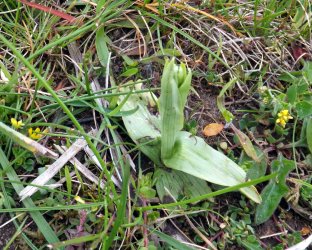 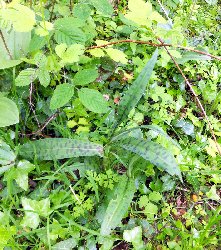 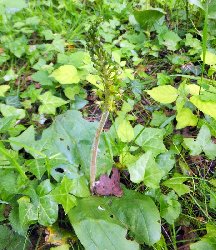
Bee Orchid, Twayblade, Common Spotted Orchid, Green-flowered Helleborine, Dune Helleborine
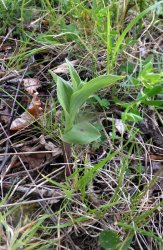 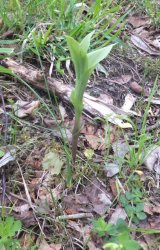
1st June 2015 Eryrys
A second visit here to have a look at the larger Frog Orchids that we had seen 10 days before. The looked like Frog Orchids, but their size and later flowering gave the possibility that they were a different species with similar leaves. In fact they were Frogs, and were reaching heights of 22cm. But the big surprise was another group of 30+ specimens were found growing under a hedge alongside the entrance track opposite the old workings. These were mainly large plants, with one reaching 30cm - a remarkable height for a Frog Orchid. Moreover, they seemed to grow in clumps, which suggests vegetative reproduction, another unusual feature for this species.
This quarry seems to harbour an unusual population - early flowering, large forms, predominantly green flowers, and vegetative reproduction.
The Twayblades had shot up and some were just starting to flower.
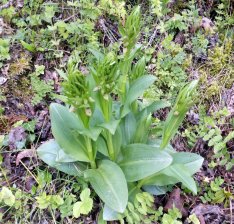 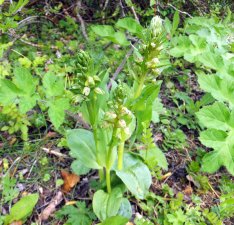
Two of the clumps
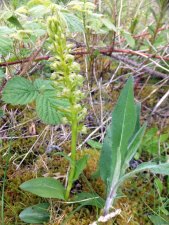 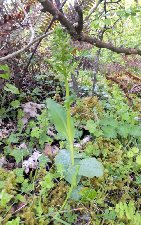 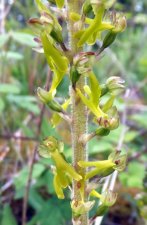
A 22cm and 30cm tall flower, plus one of the first Twayblades
More Early Purples were seen about « mile south of the village crossroads. Not as many as those seen in 2014, but singly over a longer stretch of roadbank.
Postscript. Subsequent visitors have reported further Frog Orchids across the road. The 8-spike specimen grew to 14 cm, but a single plant had attained 15cm. Dactylorhiza x venusta has been seen, though only the Common Spotted parent is recorded by me.
A long weekend break in the Lake District provides opportunities to visit some known orchid sites on the ways there (repeat visits all) and back, plus a morning on the Furness Peninsula for a real rarity. In fact the orchid spotting started on the M6 where a group of what were most likely Northern Marsh Orchids were seen just by junction 32 on the north-bound side.
4th June 2015, Warton Crags
I last visited in 2012 when this former limestone quarry boasted a small colony of Bee Orchids, all marked with sticks. Alas no more, and we were told by a local lady that they hadn't appeared in 2014 either. However there were a few scattered Northern Marsh Orchids, and the same lady informed me that the top of the crag has a fine display of Early Purples earlier in the season.
Since visiting here I have found out this cliff is also the haunt of the Dark Red Helleborine. Hardly surprising really given its distribution and preferences. That said it would have been much to early to see any.
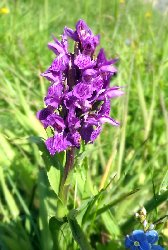 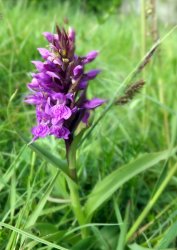
4th June 2015, Arnside Knot
A 2012 visit here had proved quite fruitless. Whether that was because we looked in all the wrong places, or July was the wrong time to visit - I was looking for Dark red Helleborine in particular. So a June visit could be more worthwhile. Instead of the woodland and the open hillside, this time we made our way to the southwest and Heathwaite Meadows. The name sounded promising and a butterfly walk was advertised there. Alas, all we found were Early Purple Orchids, largely on the way out. These grew either in large groups in the open, or under the shelter of the bushes and scrub where they were protected from grazing; we spotted a pair of Roe Deer in the meadows. So apart from that a disappointing visit, though to be honest the Knott only has recorded orchid species that can be seen elsewhere. I cannot see myself bothering to visit again.
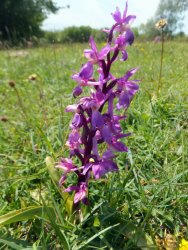 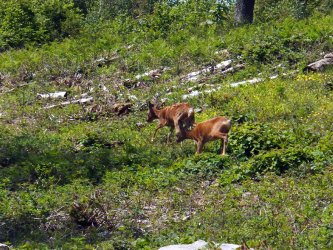
4th June 2015, Gait Barrows
Three years ago a July visit yielded only photos of Ladys-slipper Orchid leaves and one totally desiccated long-dead flower. Early June is the peak flowering season, but I had read that flowers this year are down in numbers compared to 2014. If that is the case the last year must have been really spectacular. While these are laboratory reared plants, planted out in the limestone pavement, they are at least descendants of the one known surviving British plant. The other wild plant at Silverdale has been shown to be of central European origin, so is not so wild after all. The plants grow in five clumps, and hopefully with either natural or artificial fertilisation they should eventually naturally colonise the area.
There does seem to be some variation in the upper sepal and lateral petals, with some plants exceptionally deep in colour, and in other plants having a purple-brown mottling over yellow. Natural variation or soil factors?
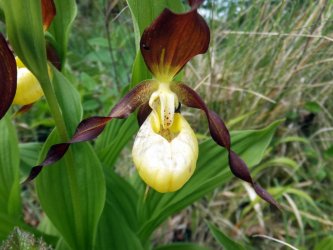 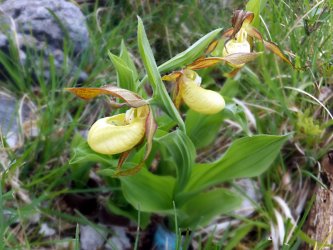 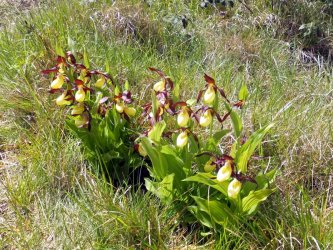
4th June 2015, Latterbarrow
This site was a late addition to the itinerary. Witherslack in south Cumbria is a recognised site for orchids, but its size and elevation sort of ruled it out as a quick stop-off on the way. Latterbarrow however is a small reserve and just off the A590, and it lies below Witherslack, so perfect. We found a Greater Butterfly Orchid, not quite in flower, near the entrance, and a few yards away the first of the Fly Orchids. There were some 25 of these in flower (that we found at least) on the higher and presumably better drained soils. I am not at all surprised now that previous attempts to find Fly Orchids (Cors Bodeilio, Homefield, Coed Abergele) were unsucessful now that I have seen them. They are more slender than I realised and the flower much smaller. Altogether an unobtrusive plant, but once seen ..... The Butterflys were even harder to spot still being largely in bud, and they tended to grow on lower slopes. Add to that a few Early Purple Orchids on their last legs. All in all, a place worthy of a visit.
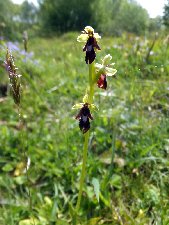 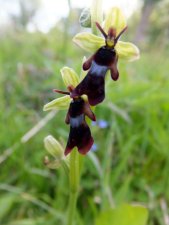 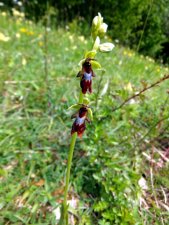 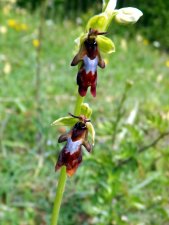 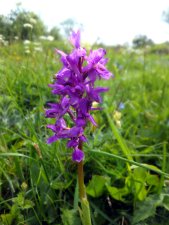 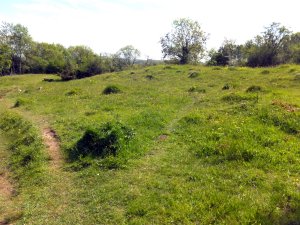 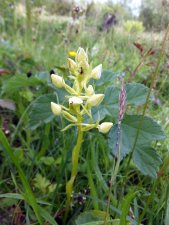
5th June 2015, Sandscale Haws
It's been 32 years since I last paid a visit to this extensive sand dune reserve. I recall the car park area and think that we went into the dunes in a more or less southerly direction, but not too far. My notes say that Dune Helleborine, Marsh Helleborine and Early Marsh Orchid were spotted.
For 2015 I had some detailed instructions from Neal, the NT Ranger, to locate the Coralroot Orchid. This year is claimed to be one of the best with censuses indicating over 2000 flowering spikes. Despite these numbers there is little chance that we would have seen any without the instructions and map. The spikes are barely taller than the creeping willow, and despite their yellow colour they just blend in. Two inches is quite typical; and it's not as if they grow everywhere. They are found in just a couple of the 30+ dune slacks on the western side over 1km from the car park. But once seen, plenty were seen.
We must have spotted a couple of hundred during the thirty minutes we were in slack #28. Some were going over, but more were yet to open fully. They grew singly or in small groups. If you do visit here, it is important to look where you tread and kneel. Without a leaf rosette, it is very hard to spot new younger flowers coming up.
Despite my recordings from the past absolutely no evidence of any other orchids were made this visit. This one is a month earlier, and a different direction taken, but I would have expected something else during the mile trek to the Coralroots.
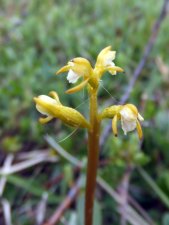 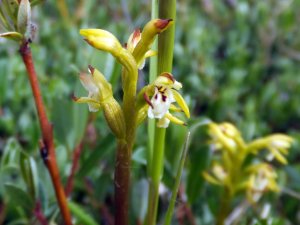 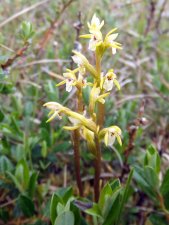
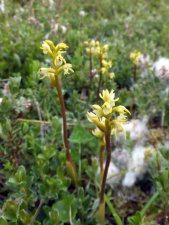 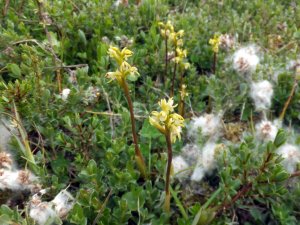 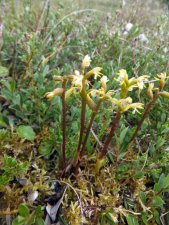
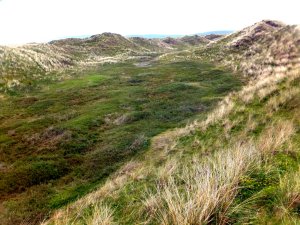
8th June 2015, Waitby Greenriggs
The journey home had a three potential orchid sites in the same bit of Westmoreland wilderness. Tarn Syke (nice Common Butterworts though) and Asby Outrakes (where the Small White Orchid is alleged to grow) failed to throw up a single spike. Waitby Greenriggs looked likely to follow this trend. This is a disused railway cutting, with rather steep and high sides in places. There could have been quite a population on those slopes but their height and steepness were a bit of a decider in staying at the bottom. Starting from the road near Waitby we went southeast and for the first 400 yards saw nothing of note. It was only when we had a look over the eastern embankment that we found some Early Purple Orchids - then a presumed Lesser Butterfly Orchid still in bud, and finally a single Fly Orchid in flower. Careful examination revealed Common Spotted Orchid rosettes, a Fragrant Orchid in tight bud, quite a few Common Twayblades just coming into flower and Marsh Helleborines pushing through. The latter were quite heavily pigmented. More Butterworts too. Passing back into the original cutting another Fly Orchid was seen on the western side. Then more were quite obvious because they were all had white plastic markers indication positions. Obviously a census or project by local conservationists. There were about 30 in two groups of widely spaced plants. A Butterfly Orchid or two in flower were also found, but no Northern Marsh or Frog Orchids were seen. But seven species after a disappointing start was quite some consolation.
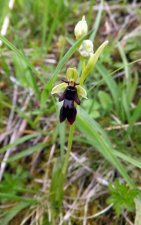 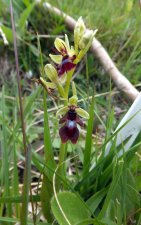 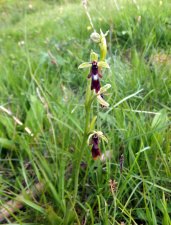 
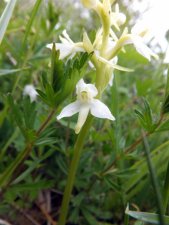 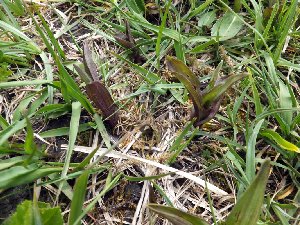 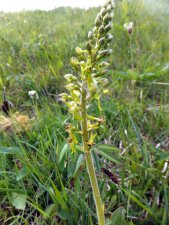 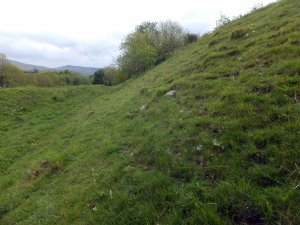
15th June 2015, Saltwells Park12th June 2015, Draycote Meadows
The third Warwickshire orchid meadow of the day, somewhere between Coventry and Rugby, was a bit of a disappointment after the other two (see below) - but only because the main show of hundreds of
Green Winged Orchids had well and truly gone over. However there were still a late few worthy of photographing to show the colours. Most of the flowers were taller, compared to the two British sites visited this year, suggesting richer and moister soil. Common spotted Orchids also grew there and included one weird looking deformed plant. The is a second field that, according to the notice board, is only open to the public during guided walks once a year during the peak flowering time. In June it was not worth a spot of trespass, but probably well worth joining in during May.
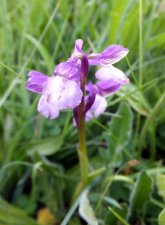 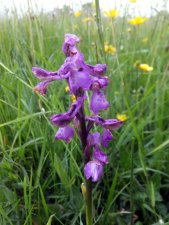 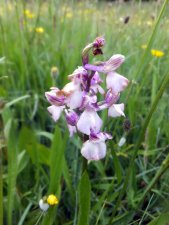 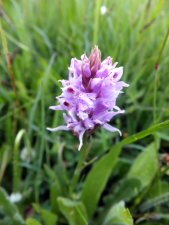 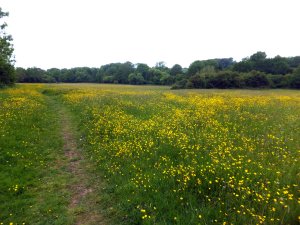
12th June 2015, Tasker's Meadow
This is another Warwickshire reserve: a meadow with adjoining former railway cutting. This has to be the best site for Greater Butterfly Orchids that I have seen. They can be found in most areas of the reserves sometimes in loose clusters of over 100 spikes. Some of the larger examples reach 45cm in height, with one found that was probably 60cm - a true giant. They also had a slight fragrances reminiscent of tangerines. A few Common Twayblades lived in the cutting where Small Blue butterflies were seen too.
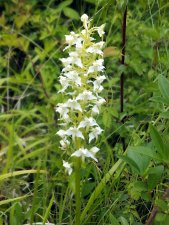 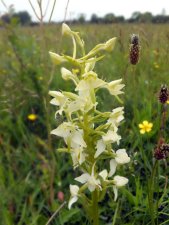 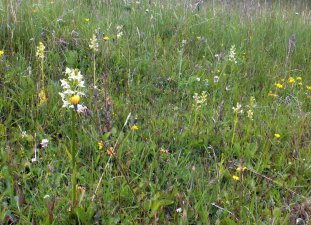 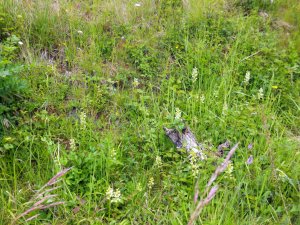 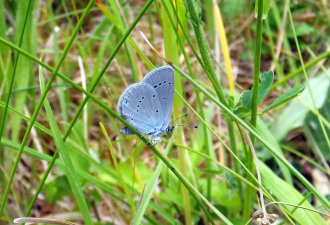 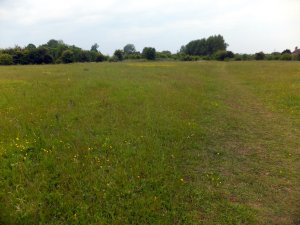
12th June 2015, Ufton Fields
An unusual location in deepest Warwickshire, this reserve is on the site of a former liassic limestone quarry with deep, water filled grooves. Now turned over to nature, much is wooded. We headed for the first meadow on the northern side where a few Common Spotted Orchids and a solitary Bee Orchid were found. So we trekked to the far side and made our way to Snipe Meadow. Here was the true prize. Plenty of Common Spotteds and Common Twayblades. Soon the Greater Butterfly Orchids were apparent, and finally the Man Orchids. These are said to be the most northerly growing colony in the UK, and consequently caged for protection. We counted just 13 flowering spikes, with a number of empty cages. The Man Orchid may not emerge every year. This colony was quite different to others I have seen in Kent, and abroad on Corfu and in Puglia. They are rather anaemic looking and virtually lack any of the red colouration which makes typical specimens look so impressive.
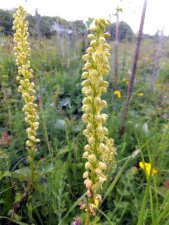 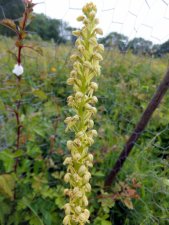 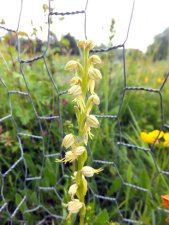
The Man Orchids
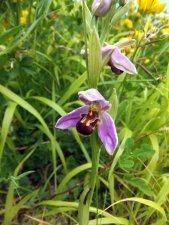 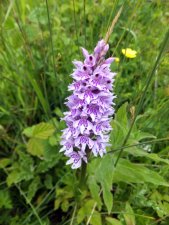 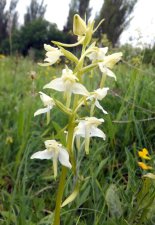 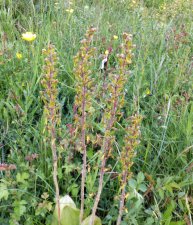 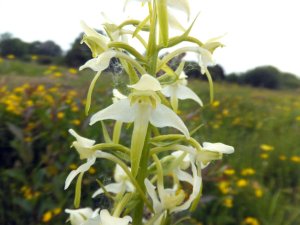
The supporting cast
15th June 2015, Wrens Nest Hill
This place is famed for its fossils more than for its orchids. A highly fossiliferous Silurian limestone hill has been virtually mined out and abandoned. We decide to walk around the hill anti-clockwise, but the orchids we saw were close to the start, at the point called The Quarry on the site maps. There were a few Southern Marsh Orchids (nowhere comparable to Saltwells below) and some Bee Orchids that were sill largely still in bud.
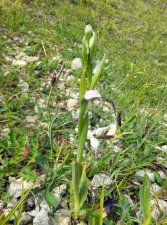 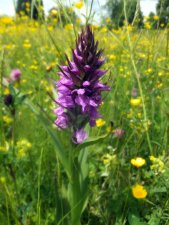
Saltwells is a former industrial site in the heart of the Black Country at Brierley Hill, which has been returned to nature. It actually covers quite a large area, and is known for its population of Southern Marsh Orchids. It was a bit of a trek from the car park near The Saltwells pub to where we eventually found them in a fenced off section alongside the Grand Onion Canal. In fact this was a bit soggy, so luckily there had not been much rain prior to the visit. Several hundreds of SMOs were in peak of flowering.
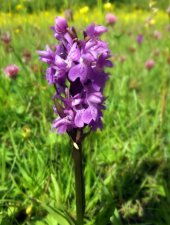 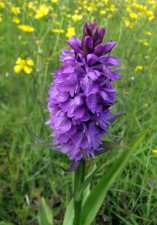 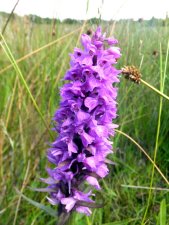 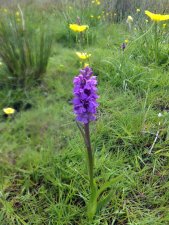
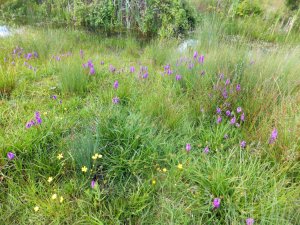 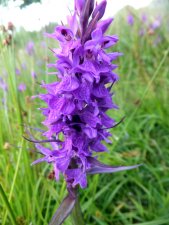 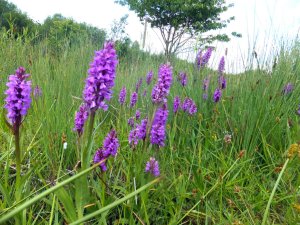
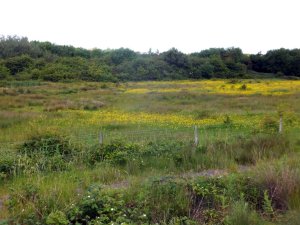
    
|
